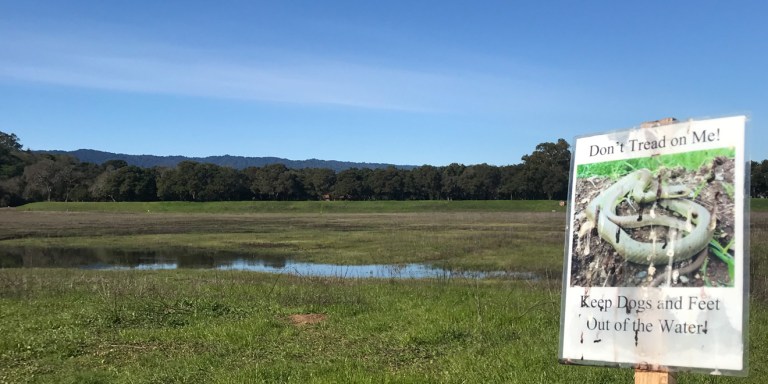Though Stanford stopped artificially filling Lake Lagunita more than 15 years ago, the site remains inaccessible by foot for most of the Stanford community. The University placed about two dozen temporary signs around the lake earlier this month, reminding community members that access to the lakebed is restricted in an effort to protect threatened species, including the federally protected California tiger salamander.
University permission is required for access to the Lagunita lakebed under Stanford’s Habitat Conservation Plan (HCP), which was proposed in 2010 and implemented in 2013 as a 50-year framework “to stabilize or increase the populations of the covered species on Stanford land and to enhance and protect their habitat, including riparian vegetation, creeks, grasslands, and seasonal wetlands.” The Foothills/Lagunita Management Group reviews requests for permission and decides whether to grant it.
This month’s signage comes as part of an ongoing effort by Stanford Lands, Buildings and Real Estate’s (LBRE) Conservation Program to enforce the HCP. Signs have been intermittently placed along the trail surrounding the lake since 2017 “in an effort to minimize the environmental impacts of human activities,” wrote University spokesperson E.J. Miranda in an email to The Daily. Sign placement is more important when the lake contains water, he added.
“That is typically when environmental issues occur,” he wrote. “The ground is soggy and easily damaged and larval amphibians are sensitive to disturbance.”
Roble Sustainability Leader Becca Nelson ’20 helped place signs around Lagunita in her freshman year, as rain filled the lakebed. While she did not take part in setting up signs this year, she noted the involvement of student volunteers.
“Because [the lake] fills up with water and it’s cool, people wanna go put a raft in there and run around because it’s a recreational space too,” Nelson said. “One of the biggest challenges is figuring out how to educate people that it’s an important habitat area, but also allow some usage of the lake path at least so that people can enjoy Lake Lag.”
Student groups such as SUAVE and BioBlitz have been granted permission to access the lakebed for study, research and environmental activities, Miranda noted. Named for an aerospace conceptual design environment built by students to analyze and optimize aircraft designs, SUAVE sometimes flies aircraft over Lake Lagunita. Meanwhile, BioBlitz is an annual event hosted on the lakebed by Stanford Stanford Strategies for Ecology Education, Diversity and Sustainability (SEEDS). Participants from Stanford and the surrounding community catalog plants and animals found in the lake over the course of the day.
To gain lake access, Nelson said, student groups need to reach out to Stanford Conservation and, if approved, meet at the department’s facility to learn about proper conduct at the lake. She noted that the process “varies based on the level of intensity of the activity.”
“The people themselves may not realize that their actions have a potential impact on the environment,” Nelson said. “So that’s why I think creating conversations and having educational programs at the lake is critical.”
The HCP specifically focuses on protection of species including the California tiger salamander, the California red-legged frog and the local variant of the common garter snake.
“Conservation is a primary function of Lagunita, but the university has maintained the ability to conduct a wide-range of other activities at the reservoir that are approved and compatible with conservation efforts,” Miranda wrote.
The University placed orange fencing at four locations around the lake in 2018 “to facilitate required biological monitoring activities,” Miranda told The Daily. The fencing appears behind Roble, near the lake’s northeastern corner, near the Narnia parking lot and by the inlet of the lake.
“The fencing facilitates the measurement of the presence of a specific organism/group of organisms over time,” Miranda wrote. “In this case, it facilitates the monitoring of California tiger salamanders.”
The threatened California tiger salamander has received special attention at Stanford under the “California tiger salamander management agreement” since its approval in June 1998.
Under the Endangered Species Act (ESA), a threatened species is “any species which is likely to become an endangered species within the foreseeable future throughout all or a significant portion of its range,” whereas an endangered species is “any species which is in danger of extinction throughout all or a significant portion of its range.”
“In many ways, the Conservation Program is in charge of the university’s compliance with federal and state laws pertaining to protected species,” Miranda wrote. “Since the federally and state-protected California tiger salamander reproduces in Lagunita, we have significant management responsibility for much of the reservoir.”
Despite the University’s restrictions, Nelson noted that she often sees people breaking various rules around Lagunita, by allowing their dogs to wander off the paths, for instance. She cited littering from parties by the lakebed as another source of concern.
“Sadly it’s actually pretty common for people to do things — maybe without realizing that you’re not supposed to go off the path — that are somewhat disruptive to the ecosystem around Lake Lag,” Nelson said.
Mirana noted that Stanford Public Safety works with LBRE “in the event a clear violation of law occurs.” However, he added, “there has not been an enforcement action from an outside regulatory entity (federal, state or county) concerning environmental compliance at Lagunita.” Lagunita will be managed similarly to how it is now “for the next 40-plus years” of the existing HCP, Miranda noted.
“Lagunita is an extraordinary place and there has been a change for the better in how members of the Stanford community view it,” Miranda wrote. “More work is needed, but with ongoing management, education and restoration, Lagunita will continue to recover and even more people will see its value — not only as a place for teaching and research, but also as a place to enjoy the remarkable flora and fauna.”
Contact Holden Foreman at hs4man21 ‘at’ stanford.edu.
